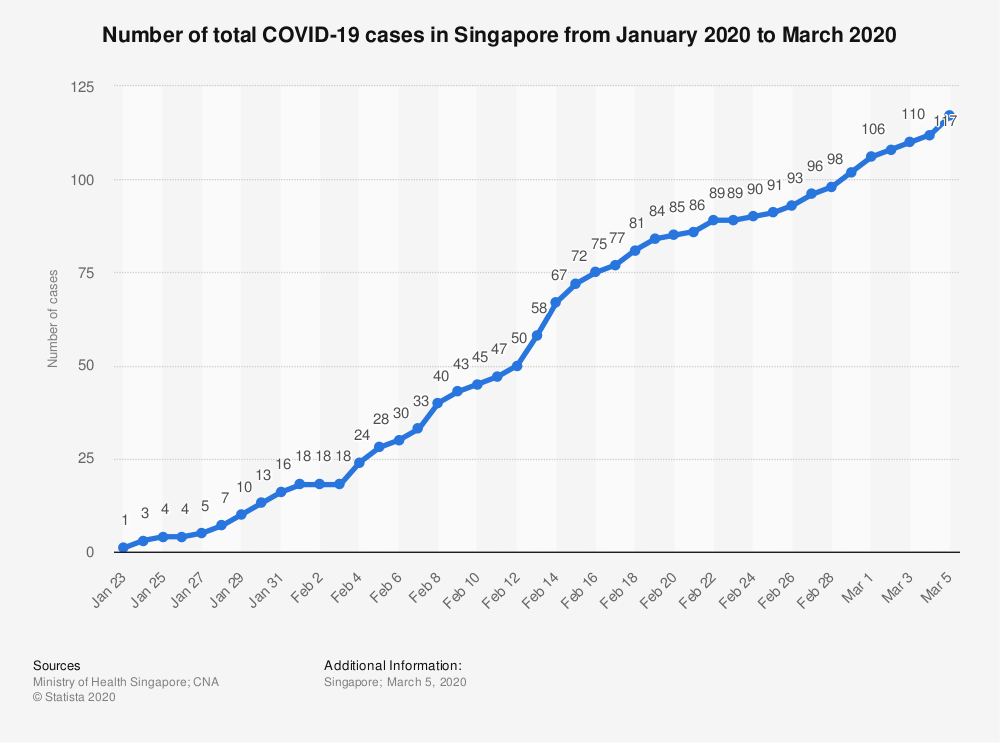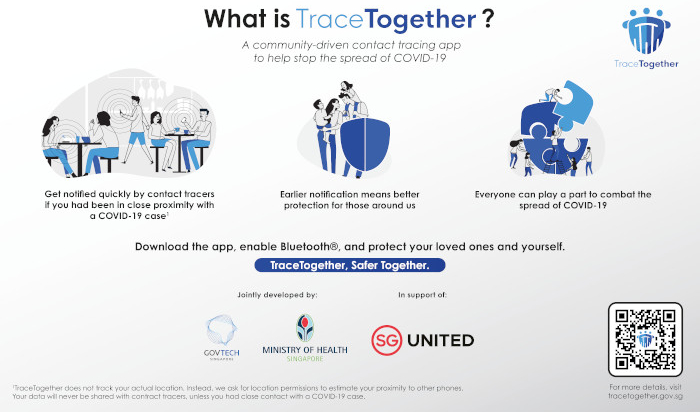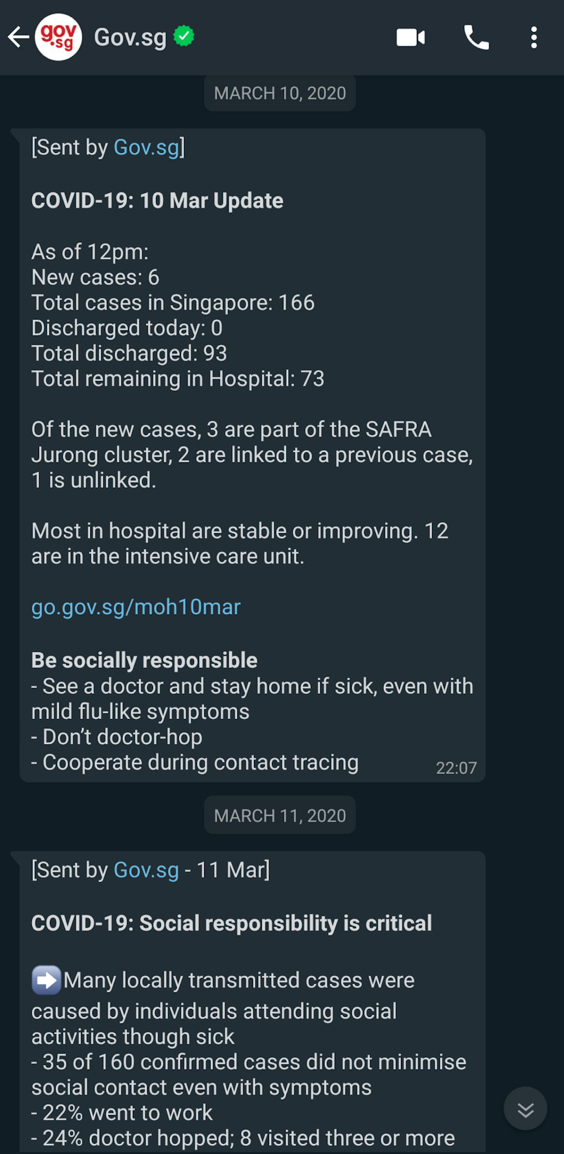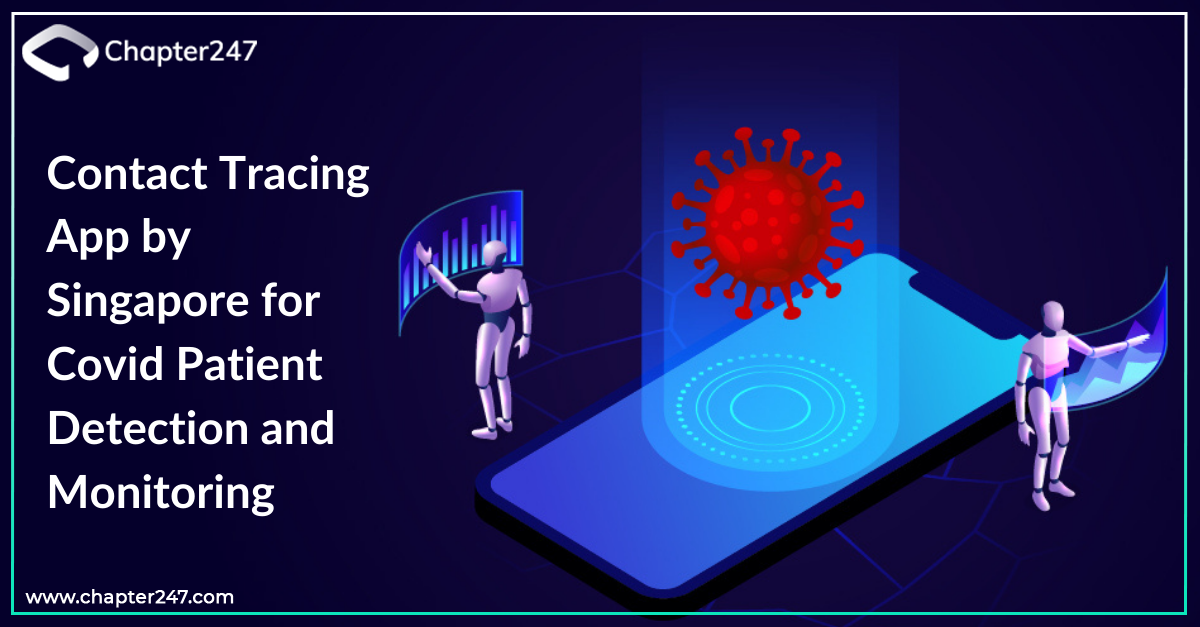Singapore is very serious about Social distancing and its regulations. If you are even a meter close to another person in any place, be it a shopping zone or a restaurant, be ready to face the wrath of the law as this can surely land you in their jails. Singapore law and order are considered the toughest in the world to implement Social Distancing during the Corona virus pandemic. The government has taken on a no-nonsense approach and has applied a comprehensive surveillance approach especially in these 2 long months of battle. It goes without saying that the international community has lavished praises on them for the manner they are able to curtail the surge in the cases.
Overall Singapore has had a controlled approach doing everything in its book to curb the spread. As of today, it has 879 positive registered cases with a massive recovery numbered at 228. With 3 deaths officially registered, it still has 629 active cases to deal with.
Given below is the chart showing the growth. Although it has not registered a flat curve, yet the rate of growth has been contained.

Source: Statista
A major reason for its strategies to work can be a combination of different measures that Singapore has adopted: a great health system, a heavy-handed approach towards tracing for infected people and a population that has accepted the government’s wide-reaching orders.
Talking about tracing measures, in this article we intend to discuss a unique app used by the Singapore Government called “Trace together” for tracing contact cases there.
Decoding Trace together – An app for contact tracing
The GovTech in association with its in-house IT agency and in collaboration with the Ministry of Health had launched a mobile app called Trace Together to support and additionally to trace the ongoing contact tracing efforts in the nation to curb the spread of COVID-19. The app was launched on 20th March and hugely dependent on the recall power of the infected citizens. For the unenlightened, contact tracing is the process of pinpointing those people who have come into contact with infected individuals.

Source: GovTech, MoH
When users download the app and give their consent to participate, the app is allowing for proactive help in the entire process.
How does the Trace Together app work?
Presently contact tracing functions essentially on the recall memory of the interviewees. There have been instances though when these people were not able to remember their contacts or had no information whatsoever. It works on the exchange of short-distance Bluetooth signals between phones to spot and detect other users with the app installed in its vicinity. The data so generated of the contacts and Bluetooth signals caught gets stored in the local phone memory. MOH also is interviewing users as a part of these efforts. Users can give their consent to sending the stored data to the Ministry for their further action.
This is how it works and the technology behind it enables contact tracers to instantly inform the users who are actually in close contact with COVID-19 cases. When the user gets alerted, he or she can act on the information. They can also immediately isolate themself and monitor their health. The Mobile application can be downloaded from the Play Store or the Apple app store.
How was the app built?
The Trace together app was built by the government’s in-house IT house. In a move to help other countries to trace the infected, the government will make the software for the mobile application which has already been installed by 620,000 people. The software will be freely available to all developers. The app will be open-sourced and its source code will be made available freely which can be modified as per the country’s condition and need. The app functions on the wireless Bluetooth technology and the developers also believe that it will still be useful when the people are not able to recollect contacts.
40 engineers were in the mobile application development process giving more than 10,000 man-hours to develop the app. The ubiquity of mobile phones with communication capabilities was the reason developers went on to connect the problem with technological solutions. Many of the existing mobile applications have been using GPS to identify people in close proximity to an infected person. GPS works great in open spaces but in enclosed spaces and urban settings, it surely is not a good strategy. Location data for contact tracing also poses serious questions on privacy and data security concerns. The user can get scared or hesitant at the least to reveal their movements. The developers understood this concern and replaced the question WHERE with WHO which the app intends to trace. The idea behind the app was that the virus is least concerned where the transmission appears, it is more concerned to know the host who is always on the move.
Location permissions are sought only for knowing the relative distance between the users and the app but does not collect real-time geographical location. The team tested with their robust manual and automated testing measures with different models. The Research wing also had anechoic chambers that would block out all the other signals as it could help in measuring base-level strength.
The entire Bluetooth hardware stack was dug deep unlike the usual mobile application development process. The app talks about a few takeaways which have resulted in the successful adoption of the mobile application. It believed that constant testing could do wonders for the veracity of the application. Based on the project and its timestamp, we as a top mobile application development company also have endeavored not just blindly using convenient technology stacks but based on the need, we adopt a
consultative strategy to understand which technology has been used. Also, our manual and automated testing methodologies are time-tested and have helped us launch several successful mobile applications.
How and where you can get any such app
There are several independent platforms that have helped thousands of enthusiasts build their own apps. But the question is with such a complex app in hand that requires the usage of heaps of data, it surely is not an advisable move. The Singapore government relied on 40 engineers to build the app which in itself proves it is quite intricate.
With more than 8 years of experience in building more than 100 mobile applications, we recommend seeking development services from an experienced software development company. The mobile application development process is the process through which the app such as virtual digital assistant, Voice-controlled, AI and conversational bots are created for mobile devices.
As one of the most preferred health-care mobile application development companies the use of the agile development method allows for rapid cyclic development of mobile applications for towering flexibility and swifter turnaround time. A situation such as this does not give a lot of time for such applications considering the urgency of it. Using the agile method also boosts productivity with a more collaborative approach.
Read know – Top 10 custom software development methodologies for software development
Privacy concerns
In order to appease any concerns related to privacy, the next-generation surveillance system installed for the app does not gather any personal details. The app does not even collect the user’s name and does not record any location data. It neither accesses the user’s phone list or scans the messages. Data logs also are stored in the phone in an encrypted form. The information on the potential close contacts is collected and saved in cryptographically generated temporary IDs. But when deemed necessary the logs can be decrypted for the Health Ministry to use it. But the efforts to track the virus might need a little retracing by using GPS because the point is not to invade privacy but to ensure it does not spread.
Privacy concerns are in fact increasing in present times when governments are relying on technology in order to track the efforts to face this pandemic. An extreme example is that of South Korea which is publishing movements of people before they were diagnosed with COVID-19. It is using not just GPS but also credit card records and video clips. Israel also has an app that warns users that they have crossed the path with someone who has been infected!
Other measures followed by the government
Singapore, back in 2003 had already built a task force in order to harmonize efforts and messaging in such times. This task force had to undergo testing in 2009 when H1N1 was registered and in 2016 when the Zika virus outbreak happened. Apart from the Trace Together app, it has also undertaken several measures:
Scaled screening in well-equipped public health clinics
Testing each and every citizen might not be feasible because it might pose pressures on the health infrastructure. Hence it is important for health systems to prioritize their duties to take on larger volumes. Singapore already had designated health preparedness clinics which were about 1000 in number. It provided not just primary care experts but also embarked on additional training in times of pandemic outbreaks.
Government is bearing the cost of diagnosis and treatments
People feel no qualms in seeking help because all the health care costs including hospitalization are borne by the government.
Aggressive quarantine measures
‘Stay at home’ notices have been issued to several workers who are returning from countries with the transmissions. In fact, they are legally enforceable also and people who do not follow the orders are severely prosecuted under the law.
Constant public health communication
The communication regarding the current situation has been constant, transparent and truthful. If there are gaps in the communication process, they have been truly acknowledged

Source: StatNew
The road ahead
WHO also has stated that contact tracing can be an important measure to understand the extent of the infection and would also go a long way in preventing further transmissions. Singapore had recorded its first set of cases by the end of January and the doctors immediately identified these cases and isolated them. Almost concurrently contact tracing also started. The approach by the government has been extremely successful in curbing the spread of COVID-19 in the country.
As a pro-active mobile application development company, we have understood that apps of this nature require team readiness and high-tech tools adaptability. Throughout our span of existence, we have always displayed such astuteness in our app development process.
Have any questions? Or want to create an app to provide support measures for COVID-19? Ask us.







